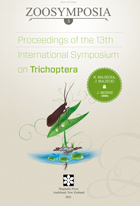Abstract
Case-building is energetically expensive and case-repair may be a viable alternative to rebuilding for caddisflies when the case is damaged. In this study, we damaged the larval cases of 3 Trichoptera genera: Lepidostoma spp.; Neophylax rickeri Milne, 1935; and Onocosmoecus unicolor (Banks, 1897). We manually damaged the anterior, middle, or posterior portions of the larval case. We measured case lengths before damage, immediately after damage, and after allowing 2 days for repair. Overall, 74.2% of Lepidostoma spp. (n=31), 23.5% of N. rickeri (n=34), and 50.0% of O. unicolor (n=44) repaired their cases. Lepidostoma spp. had the highest odds of repair (2.88:1), followed by O. unicolor (1:1). Neophylax rickeri (0.308:1) was unlikely to repair its case after damage. For all genera, the percentage of the damaged portion repaired by location was not statistically significant. In Lepidostoma spp., at all locations, the average percentage of the damaged portion repaired was greater than 100% (larvae repaired the damage fully and continued to add material to the anterior end of the case). The occurrence of repair across the 3 genera at all damage locations suggests that the behavior may be beneficial for protection and more energetically favorable than entirely rebuilding the case, however life history may influence the likelihood of repair.

